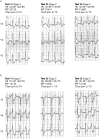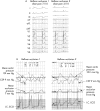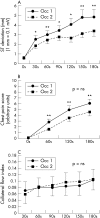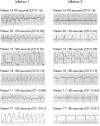Antiarrhythmic and anti-ischaemic effects of angina in patients with and without coronary collaterals
- PMID: 12433889
- PMCID: PMC1767466
- DOI: 10.1136/heart.88.6.604
Antiarrhythmic and anti-ischaemic effects of angina in patients with and without coronary collaterals
Abstract
Objective: To determine whether the changes in the manifestations of myocardial ischaemia during sequential angina episodes caused by exercise or coronary artery occlusion are collateral dependent.
Methods: 40 patients awaiting percutaneous transluminal coronary angioplasty for an isolated left anterior descending artery stenosis underwent three sequential treadmill exercise tests, with the second exertion separated from the first by 15 minutes, and from the third by 90 minutes; 28 patients subsequently completed two (> 180 s) sequential intracoronary balloon inflations with measurement of collateral flow index from mean coronary artery wedge, aortic, and coronary sinus pressures.
Results: On second compared with first exercise, time to 0.1 mV ST depression (mean (SD): 340 (27) v 266 (25) s) and rate-pressure product at 0.1 mV ST depression (22 068 (725) v 19 586 (584) beats/min/mm Hg) were increased (all p < 0.005), while angina and ventricular ectopic beat frequency were diminished (p < 0.05). This advantage, which had waned by the third effort, was independent of collateral flow index. Similarly, at the end of the second compared with the first coronary occlusion, ventricular tachycardia (21% v 0%, p < 0.05), ST elevation (0.47 (0.07) v 0.33 (0.05) mV, p < 0.005), and angina severity (6.1 (0.7) v 4.6 (0.7) units, p < 0.005) were reduced despite similar collateral flow indices.
Conclusions: In patients with coronary artery disease, ventricular arrhythmias, ST deviation, and angina are reduced during a second exertion or during a second coronary occlusion. This protective effect can occur independently of collateral recruitment. These characteristics, together with the breadth and temporal pattern of protection, are consistent with ischaemic preconditioning.
Figures




References
-
- Heberden J. Letter to the Editor. Medical Transactions, College of Physicians London 1785;3:1–11.
-
- Yellon DM, Baxter GF, Marber MS. Angina reassessed: pain or protector? Lancet 1996;347:1159–62. - PubMed
-
- Murry CE, Jennings RB, Reimer KA. Preconditioning with ischaemia: a delay of lethal cell injury in ischemic myocardium. Circulation 1986;74:1124–36. - PubMed
-
- Kloner RA, Bolli R, Marban E, et al. Medical and cellular implications of stunning, hibernation, and preconditioning: an NHLBI workshop. Circulation 1998;97:1848–67. - PubMed
Publication types
MeSH terms
LinkOut - more resources
Full Text Sources
Medical
